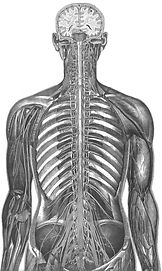

neurofascial approach to
WHIPLASH TREATMENT
about the course
Our focus in this class is evidence-informed assessment and ecological treatment strategies of Whiplash and Whiplash-Associated Disorders. Our focus will be on treating the nerve-fascia interface, including the dural sheath, myodural junction, the nerve roots and their immediate connections, and the innervated deep fasciae of the neck.
Why is Whiplash so hard to recover from? What makes it escape adequate treatment for so many patients? Part of the answer is that a musculoskeletal strain/sprain condition coincides with a trauma disorder
an overwhelming stimulus leading to dysregulated protective behaviors. These behaviors include pain, stiffness, inflammation, and hypervigilance.
But if we approach Whiplash from a purely 'neuro-affective' practitioner perspective; their treatment is also likely to languish due to real localized tissue injuries. Spinal joints and ligaments and muscles really do experience everything from irritated stretch to partial rupture. Healing from these injuries is tremendously aided by practitioner able to locate and work with them.
A person with whiplash is in pain, their movement is limited, they often experience dizziness, dysautonomia, and nerve entrapment.
In this class, we will learn to:
1) Understand these as linked phenomena, and
2) Contact the key tissue interfaces and sensory processes that aid a whiplash patient's relief and recovery.
We will learn to navigate:
• Nested Fascial Layers in the neck
• Nerve Roots, Dorsal Rami, and their immediate fascial container.
• Synovial Joints and deep ligaments of the neck, along with their innervation.
We will attempt not to get stuck in purely biomechanical or overly abstract pain-science models.
Too many persons experiencing whiplash get treated by 'armchair therapists', unable to meet the complexity of real bodies, and now we've got the chance to make a difference. Can we do it?
This course will provide specific, intuitive, and evidence-informed model of manual therapy for whiplash.
Click here to register.
continuing education certification
ONLINE OR IN-PERSON
-
This 4-hour Continuing Education class is open to all healthcare practitioners licensed in Manual/Massage Therapy, and meets the WA state CE requirements for physical therapy and massage therapy.
NOTE: All virtual classes have a 'live' option, or can be viewed on your own time. All attendees will receive pre-class content, live class recording, supplementary materials, and a follow-up quiz for CE credit.
class format
Once registered, attendees will:
-
receive pre-class videos via email to watch in preparation
-
class (live or in-person) (10am-2pm)
attend class which includes the above lecture and a hands-on demo/practice session. A Zoom link will be provided for those joining online. A recording of the session will be provided at the end of class
-
receive a follow-up quiz to grant you a Continuing Education Certificate for completion
